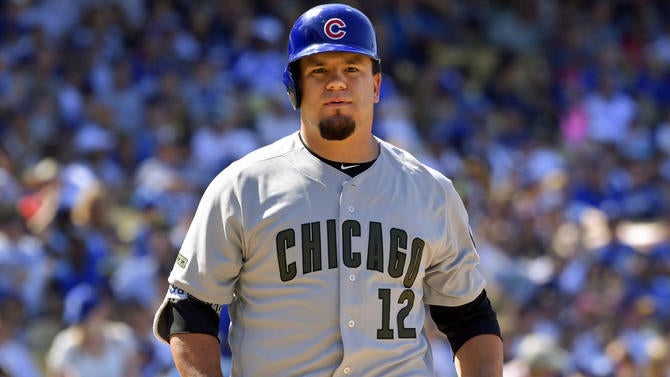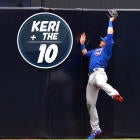 Welcome to this week's edition of Keri The 10! As always, we'll go around the majors with 10 stories that caught our eye from the past seven days. There will be numbers, and occasionally, memes. As always, we will have fun.
Welcome to this week's edition of Keri The 10! As always, we'll go around the majors with 10 stories that caught our eye from the past seven days. There will be numbers, and occasionally, memes. As always, we will have fun.
1. Houston, we have a search for a clever Astros pun
They scored 6.2 runs per game in May, the highest mark in baseball by a mile. They went 22-7 in May, matching their best month in franchise history. They've won seven games in a row. They own the best record in baseball, as well as the best run differential. As we charge into June, the Houston Astros are the best team in the majors, by a comfortable margin.
With apologies to the Keuchel-and-McCullers-led rotation, and a bullpen full of strikeout mongers, we need to talk about the Astros offense. A few notes on Houston's batting prowess:
- On Wednesday, they set season highs in runs (17), hits (19) and home runs (six) in a 17-6 win over the Twins.
- In that game, George Springer went 4 for 4 with 10 total bases and two walks. According to Elias Sports Bureau, only one other leadoff hitter in the history of baseball has ever pulled off that collection of feats in one game: Joe Gordon, in 1940.
- In sweeping their three-game series against the Twins, the Astros set a club record for most runs scored in three games. Forty.
- Stats hound Ryan Spaeder passed along this gem: From the seventh inning on this season, the Astros have scored 117 runs(!!!). That's the highest total in baseball, by far.
- Carlos Correa started the season as one of the most disappointing hitters in the league. He then hit .386/.457.673. As Astros beat writer Brian McTaggart noted, Correa's hitting .516/.545/.871 with three homers and 10 runs batted in during Houston's seven-game win streak.
- Fans and analysts actually expected big things out of Correa. Not so for Marwin Gonzalez. The 28-year-old superutilityman has played all over the diamond this season, getting everyday playing time. Rightfully so. Gonzalez set a career high for home runs last season, swatting 13. He's already got 12 this year, and is hitting a superhuman .308/.401/.638. Only five players have been more potent on a park-adjusted basis, and that list includes Bryce Harper and Mike Trout.
- No one summed up Houston's recent rampage better than Astros director of pro scouting Kevin Goldstein, who had the perfect GIF for the occasion:
— Kevin Goldstein (@Kevin_Goldstein) May 31, 2017
The Astros are a shining example of how tanking can pay off. They've gone from a three-season stretch in which they lost 106, 107, and 111 games (accompanied by multiple games that fetched 0.0 local TV ratings) to being the toast of baseball. If Houston keeps winning, don't be surprised if we see other teams try to copy the salted-earth approach to rebuilding.
2. A very quick Harper-Strickland take
Lots of ink has already been spilled on this week's Giants-Nationals brawl, caused by Hunter Strickland deciding that a hitter crushing him fair and square in the playoffs (twice) warranted throwing a mid-90s fastball at him. So I'll just say this:
Good for Buster Posey. While many commentators questioned Posey's decision not to intervene after Strickland acted like an idiot, in reality Posey was smarter than anyone else out there. Why defend the actions of a teammate when they're both stupid and dangerous? When teammate Mike Morse got hurt after Morse collided with fellow Giant Jeff Samardzija, Posey's restraint looked even smarter.
It's pointless, dumb, and dangerous for pitchers to throw at hitters. Anywhere else but on a baseball field, you'd be tossed in jail for throwing a projectile at another human being at 95 mph. Strickland should have been suspended for 20 games, MLB should forever stamp out this misguided display of faux machismo that is throwing at hitters, and Posey should have been given a damn award for using his head while everyone else seemed to lose their own.
3. The kids are alright, Part 1
Future Hall of Famer Miguel Cabrera gives rookie Eric Skoglund a thumbs-up during Skoglund's major league debut:
Miguel Cabrera giving a thumbs up to Eric Skoglund during his major league debut pic.twitter.com/4Z6UphnIhK
— MLB Tweets (@Tweet_MLB) May 31, 2017
4. The kids are alright, Part 2
Rays first baseman Logan Morrison brings a young fan on the field in Arlington to play catch:
Logan Morrison brought a young fan onto the field to warm up with him (📹: r/baseball) pic.twitter.com/E1H90G8Gs8
— Sports Illustrated (@SInow) May 30, 2017
5. The Cubs are not alright
The Cubs limped home Wednesday at the end of a disastrous road trip, losing six in a row, including three straight to the lowly Padres. That marked the first time they'd experienced a winless, multi-city road trip in nearly five years. Heading into Friday's action, the Cubs sat at 25-27, having allowed exactly as many runs as they'd scored. On this date in 2016, they were 36-15, with a run differential of plus-129.
As you might expect from a team that's suffered this sharp a fall, the Cubs' problems are numerous. Addison Russell's nosedived to a brutal line of .213/.294/.345. Albert Almora's flashed a fine glove, but he's got just seven extra-base hits in 43 games. His hoped-for replacement Ian Happ has gone ice-cold after a hot start, with just three hits in his past 10 games. On the pitching side, Jake Arrieta's pitched better over the past couple weeks, but the former Cy Young winner still owns a 4.60 ERA. John Lackey looked better on Friday against the Cardinals, but he's still served up a jarring 14 long balls in 11 starts.
Still, judging by the headlines, the biggest share of blame has been tossed on Kyle Schwarber's head. You can understand that frustration, to a point. Schwarber made an electric major league debut in 2015, mashing 16 homers in 69 games (nice). Then after missing nearly the entire 2016 season, he returned for the World Series and became a pivotal hitting star for the Cubs when they needed it most. Entering his age-24 season, the sky seemed the limit for the Schwarbs.

Instead, it's been an ugly ride. Schwarber's batting just .163/.284/.337. Already a major liability in left field, Schwarber becomes one of the worst players in the league when he's not hitting. The Cubs continue to throw him out there anyway, though with a gradually diminishing role: Once the team's leadoff hitter, Schwarber batted seventh in Friday afternoon's 3-2 win over the Cards, going 0 for 2 with two strikeouts in the process. He's already been relegated to a platoon, and could lose more playing time if he keeps going at this rate; he's making less hard contact than he did in 2015, and his line-drive rate ranks among the lowest in the NL.
Still, Schwarber shouldn't be getting this big a share of the blame. Those wondering if Schwarber might benefit from time in the minors should ask the same question of Happ, who's struggling just as badly lately and has very little big-league track record to go on. Russell's been the best defensive shortstop in MLB by Defensive Runs Saved (plus-9) this year, but Javier Baez is a great defender in his own right, and he's outhitting Russell by a wide margin, making you wonder if middle-infield playing time should be divvied up a little differently. Meanwhile, the rotation is far more suspect this year with Arrieta and Lackey struggling, creating a tough challenge for Cubs bats when two of their higher-paid arms aren't producing.
The Cubs still have so much talent on the major-league roster and remaining in the minors, you have to figure they'll either improve without drastic changes, or else have plenty of ammo to make the kind of deals they need to vault back into the race. Just as we shouldn't blame the team's struggles on one guy, it'll take rebounds from multiple players for that championship form to return.
6. More Like Nick Greaty
We've reached the point in the season where you can start to lend credence to certain off-the-charts statistical performances. For instance, if a player were hitting .400 this late in the season, you'd have license to get excited.
With the calendar flipped to June, only one pitcher who's been on a major-league roster all season long sports a 0.00 ERA. That pitcher? Indians right-hander Nick Goody.
A sixth-round pick by the Yankees in the 2012 draft, Goody landed in Cleveland at the end of last season as part of a trade that seemed so inconsequential, a player to be named later was the return. Credit the Tribe for pursuing a pitcher who'd been a strikeout machine in the minors and in his rookie season (34 Ks in 29 innings last year with New York). The strikeouts followed him to Cleveland, with Goody punching out 22 batters in 20 1/3 frames. What's changed is everything else. The 25-year-old northpaw chopped his walk rate to 6.9 percent, and has yet to allow a home run, after serving up seven in that partial-season performance last year. His swinging strike rate, hard contact rate, and line-drive rate have all improved too. All of that's happened with little change in his pitch usage or pitch velocity; he's a fastball-slider guy who's simply delivering much better results as he gets accustomed to American League hitters.
Goody's emergence, combined with Cody Allen and Andrew Miller remaining virtually unhittable, makes Cleveland's bullpen a force yet again this season. Given the Indians' struggles in other areas, that's an encouraging sign as the Tribe pushes to retake command of the AL Central.
7. Miguel Sano snake!
With Mike Trout out six-to-eight weeks with a thumb injury, you can make a case for Miguel Sano as the current AL MVP favorite. Trout aside, only Aaron Judge and Aaron Hicks have rung up better (park-adjusted) offensive numbers among American League hitters.
Just don't call him one-dimensional. As this fake snake prank shows, Sano has a chance to enter the ranks of the game's elite jokesters too.
Head on a swivel at ALL times around @SanoMiguel. pic.twitter.com/8EmdyR9d1F
— MLB (@MLB) May 28, 2017
8. It's sometimes Sonny in Oakland
The trade market for starting pitchers could be frighteningly thin this summer, with contending teams potentially forced to go dumpster-diving for arms. One of the few starters who could become both available and highly useful is A's right-hander Sonny Gray. For more on Gray's potential marketability in the weeks to come, let's check in with our pal, pitching analyst Nick Pollack of ThePitcherList.com.
After a strong 67-inning rookie campaign in 2013, Gray solidified his status as one of the better starters in the American League, posting 3.08 and 2.73 ERAs in 2014 and 2015, backed by big groundball rates (55.9%, 52.7%) and plenty of weak contact. At his best, he wielded a big slider to send disheartened hitters back to the bench.
Things weren't nearly as rosy in 2016. Injuries limited Gray to just 117 innings pitched. When he did take the mound he was awful, with his ERA ballooning to a brutal 5.69. Bad luck factored into his decline, with his strand rate dropping to 63.9 percent (one of the lowest marks in the league) and nearly twice as many of his flyballs soaring over the fence for home runs. Bad command was likely the bigger culprit, though. As Pollack explains:
"His curveball's zone rate plummeted from 49.0 percent to 38.5 percent, making it harder to get ahead of batters and set up a strikeout. His slider followed the same path, dropping nearly 11 points in zone rate, while getting batters to chase the pitch outside of the zone less often by almost eight percentage points. The result was 3.23 walks per nine innings, the highest of his career. Without the ability to rely on his premium secondary pitches, Gray was forced to do more with his fastball and it was hammered constantly. Batters hit .364 against his two-seamer, .298 against his four-seamer. His struggles to throw his curveball and slider for strikes cost him dearly."
We've seen flashes of improved performance this year. Making his season debut on May 2 after missing the first month of the season with a bad back, Gray carved through the Rangers, Red Sox, and Marlins lineups, striking out 22 batters and allowing a paltry line of .179/.233/.254 over 19 innings. But then the Indians crushed him for seven runs on nine hits in 4 2/3 innings on May 30, stalling his progress. Gray's underlying numbers show that some problems remain. Pollack again:
"Has Gray changed his approach or has he reclaimed his ability to throw his slider and curveball for strikes? The short answer: no. Gray is struggling mightily to earn strikes with his slider, throwing it in the zone just 14.9 percent of the time (33.9 percent in 2015) while not getting enough swings off the plate to justify its location (38.8 percent O-Swing compared to 49.6 percent in 2015). Meanwhile, his curve is still not the dependable strike it once was, holding a 40.8 percent zone rate compared to the 49.0 percent mark in 2015.
Most shocking, however, might be the poor command of his two-seamer, the pitch that has allowed Gray to induce groundballs well over the 50 percent mark for this career. In 2017, Gray is throwing his two-seamer in the strike zone just 44.5 percent of the time. This is an astonishingly low mark for a pitch that is supposed to set the foundation for his breaking pitches. While he's not issuing as many walks, Gray is getting behind batters often, allowing them to sit on their ideal pitch and clobber it for extra-base hits: 28.6 percent of the flyballs that Gray has allowed on his two-seamer have gone for home runs."
There might be some small-sample noise here, with Gray making only six starts so far this season and perhaps still shaking off some rust following a long layoff. But if the A's want to get a big return for their most tradable starting pitcher, they'll have to hope for more consistent results from now into July.
9. Charlie Blackmon, enigma
The Rockies leadoff hitter appears in this column for the second straight week, this time for being ... confusing. Even acknowledging the wild effects that Coors Field can have on offense, check out his home/road splits this year:
- Blackmon Home, 2017: .387/.431/.840
- Blackmon Road, 2017: .262/.287/.410
That's a little weird. Really flummoxing (and also funny, to be fair)? Check out the Rockies bench's reaction after Blackmon recently came to bat needed just a double to hit for the cycle, lashed the ball for a hit that took a while to retrieve ... and stopped at first.
.@Chuck_Nazty needed a double for the cycle.
— Colorado Rockies (@Rockies) May 27, 2017
He hit one into the outfield.
He stopped at first.
The reactions are priceless. 😂 pic.twitter.com/GsSX2x0rcr
10. Burning Question of the Week
Will we ever see another Vladimir Guerrero?
--Jonah K.
OK, I cheated here. But only because you need to see this incredible display of hand-eye coordination by Rays leadoff man Corey Dickerson, himself a back-to-back Keri The 10er. Yes folks, he hit that off the bounce.
Corey “Vlad” Dickerson. pic.twitter.com/qhEyMqiMFn
— MLB (@MLB) May 31, 2017
Send a Tweet to @jonahkeri using hashtag #KeriThe10 to submit questions for future No. 10s.


















